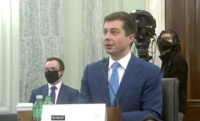The Senate has approved President Obama’s nominee to head the Dept. of Transportation, Charlotte, N.C., Mayor Anthony Foxx, to be the next DOT Secretary.
Foxx was confirmed for the top DOT post on June 27 by a 100-0 vote. He will succeed Ray LaHood, who has led DOT since January 2009.
Many tough issues lie ahead for Foxx as he moves into his new job. The top construction industry priority will be addressing the flagging financial health of the Highway Trust Fund, the major financing source for highways and an important revenue stream for transit projects, too.
The Congressional Budget Office has estimated that the trust fund’s highway account will fall into a deficit position late in calendar 2014—about the time when the current surface transit authorization measure, the Moving Ahead for Progress in the 21st Century Act (MAP-21), expires.
Jay Hansen, National Asphalt Pavement Association executive vice president, says, “For the construction industry, the number-one issue is finding new revenues to make the [highway] program whole. We’re about $10 billion short, come [fiscal] 2015, to support the ongoing spending in the program.”
Hansen adds that industry officials want to expand highway spending beyond current levels. “So finding revenues over and above what we need to just sustain the program is going to be very challenging,” he says.
Without new revenue, surface transportation programs would have to be trimmed.
Dave Bauer, American Road & Transportation Builders Association senior vice president of government relations, says, “I think it’s pretty hard to look at the fact that the Highway Trust Fund is facing a situation where highway and transit [spending] would have to be cut by 92% in about 15 months and not think that that—if not the biggest priority for the largest program in the U.S. Dept. of Transportation—it’s certainly got to be in the top three.”
Bauer doesn’t expect any major policy changes from the LaHood tenure. “The administration has four years' worth of foundational work in place and I think that it’s hard to presume that we’re somehow going to see a major sea change in the way it approaches transportation policy matters….”
DOT also is busy producing the many new regulations for highways and transit that MAP-21 mandated. Hansen says that in particular, NAPA is watching to see what sort of rules DOT proposes dealing with national performance measures for pavement and bridges.




Post a comment to this article
Report Abusive Comment